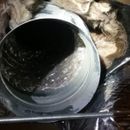Persistent condensation on ERV fresh air supply duct
I have a deep energy retrofit here in Chicago and discovered to my dismay that I have a lot of condensation on my ERV fresh air supply duct. The rigid duct from the outside fresh air intake into the ERV closet is insulated with foam and doing fine. The problem lies with the 36 inches of insulated flex duct, which connects the ridged duct to the ERV. The fiberglass at the bottom of the flex duct was soaking wet (see image).
I did follow the installation recommendation for the flex duct piece and made sure I had it zipped up tight. It seems like that’s not enough!
There must be a better way or better product to connect from the insulated ridged duct to the ERV. Any experience, suggestions or recommendations would be greatly appreciated!
GBA Detail Library
A collection of one thousand construction details organized by climate and house part










Replies
Marcus,
Flex duct insulation isn't ideal. The trick is to make sure that the vinyl jacket is airtight. In theory, if the vinyl jacket is airtight, there is no way for humid indoor air to contact the cold duct. In cases like yours, there is usually a flaw in the vinyl jacket (or a seam).
If this is really bugging you, and you want a perfect job, you can use rigid galvanized duct and insulate the duct with spray foam (using a two-component spray foam kit). Not cheap, but it would work. (If you do it, mask the ERV carefully to avoid an overspray disaster.)
-- Martin Holladay
To add to this thread, I'm in climate zone 7a and just noticed the same on my fresh air supply duct... only my furnace is an older forced air. This is rigid galvanized and not Flex. The insulation is quite wet and frozen half way to the furnace. I'm going to take off all of the insulation and dry and clean the duct as best as I can, then planning to seal all seams and joints with aluminum foil tape, then insulate around it with Roxul instead of fiberglass, and then wrap that with a foil wrap.
At the point of entry into the house, I was going to add a thick bead of polyethylene sealant around the duct that's suited for cold weather, and then spray foam. I was on using something like Great Stuff in combination with some XPS in that joist area to get it well insulated and 100% sealed. Martin, as per your response to Marcus, are you recommending the 2-component spray foam over what I was planning to do?
Thanks
Todd
Todd,
I'm eager to hear the results of your experiment. Frankly, I'm not sure of the permeance of one-component spray foam -- I suspect that it may be somewhat more vapor-permeable than two-component foam, but I may be wrong.
-- Martin Holladay
Martin,
You're probably right, plus it's not advised to be used greater than 3" thick. My reasoning was the cold weather polyethylene sealant like Vulkem 116 vs Osi Quad will do the bulk of the sealing, and the 2 to 4 inches of XPS around the duct and filling most of the space and sealed with Great Stuff would be sufficient and much more cost effective for this single application.
Though, I just noticed one can buy the smaller 15 board foot 2-component spray for $40.
Thanks again for your input.
Todd
Martin, thank you for your response! The rigid galvanized duct is insulated with spray foam and I have no condensation issues there. The condensation is just at the three feet of flex duct, which I need for sound and vibration isolation.
Like you, I suspect my vinyl jacket wasn't completely air tight. There are no breach in the jacket itself, but I think air is leaking in at the connections to the rigid duct and the ERV. Again if anyone has tips on how to get these connections tight, I would love to hear about it. Or if anyone knows of a product that would give me the sound and vibration isolation, but would be easier to install with air tight connections, I would love to hear about that too.
Todd, if your fresh air supply duct is all rigid galvanized duct, I would definitely go with Martin's recommendation: 2-component spray foam. Has worked great for me.
Marcus